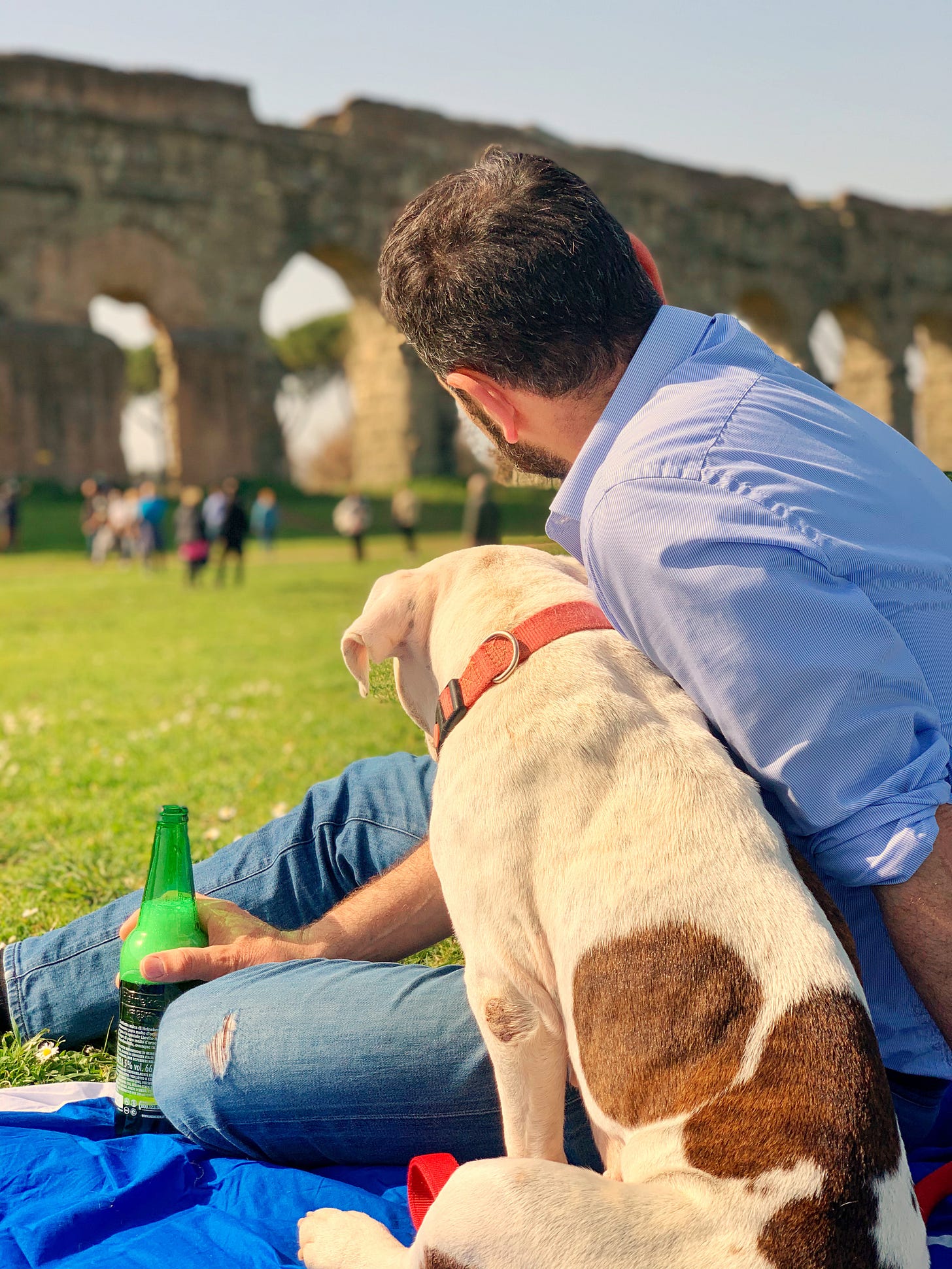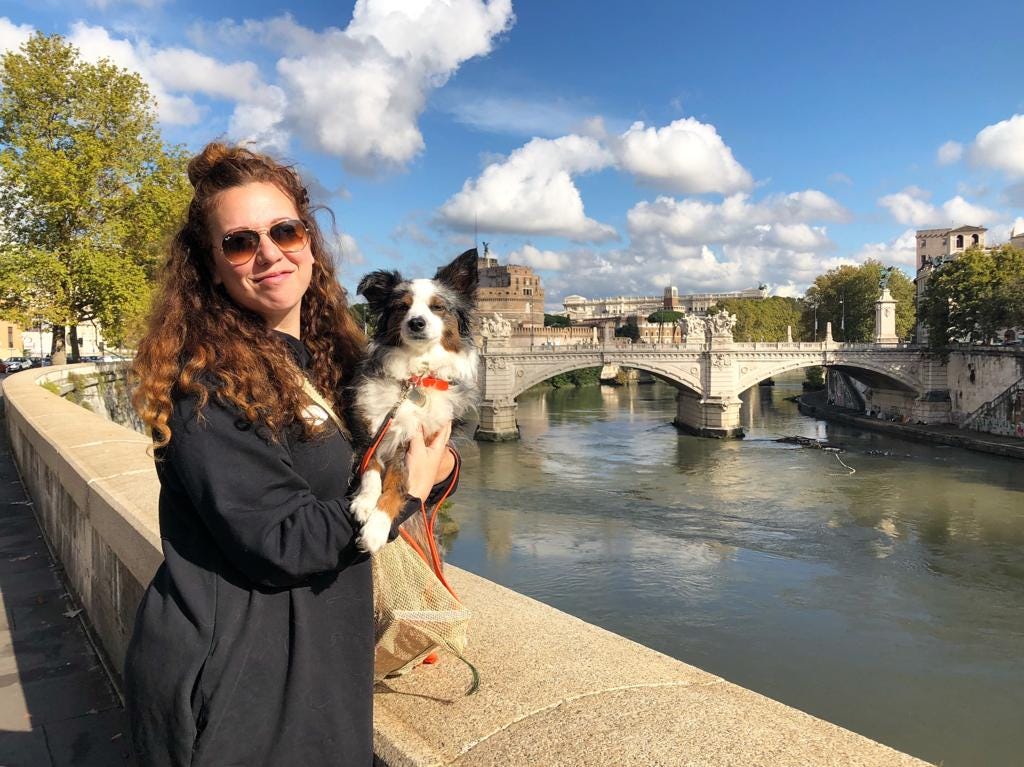I was planning to send out a newsletter on a completely different topic today, but yesterday my husband Marco and I had to say goodbye to our sweet, beloved dog Pepita and quite frankly any other subject now seems trite. To say that we loved this dog is a massive understatement—she was a crucial member of our family and the absolute best companion. She was literally born in Marco’s house a few months before I met him and when I moved into this house in January 2021, we quickly formed an unshakeable bond.
Pepita was a bit timid, but if you were in her circle, she lavished you with affection. If there was an Olympic championship for cuddling, she would win it. She would follow me around and dance with me to Harry Styles or Dua Lipa, wagging her tail and moving her little body to the music. We called her a gourmet dog because she would sometimes shun her kibble, preferring finer foods like prosciutto, parmigiano, and homemade fish or broth.
As her health declined rapidly over the past week, and we spent more time tending to her needs, she occupied more and more of my thoughts until I couldn’t concentrate on anything else. Yesterday, after she had passed, I began to wonder about the role that dogs played in ancient Rome and how they’re seen today. So I decided to take a deep dive into the subject. This newsletter is dedicated to her.
One of the most iconic symbols of ancient Rome is the she wolf suckling Romulus and Remus. Ancient Romans sacrificed animals to the gods, used dogs in battle, and paraded exotic beasts brought from the farthest reaches of the Empire out onto the floors of arenas like the Colosseum. But did they keep dogs in their homes as pets? It turns out they did.
According to a 1949 article in The Classical Journal titled Greek and Roman Household Pets, “Writers of all classes celebrate the canine's attachment for man, and, from the most distant antiquity, the dog is the symbol of fidelity.” As the author, Francis D. Lazenby, explains, Greek writers Plato and Homer both mention dogs and their admirable qualities of faithfulness, courage, and gentleness, and dogs often appeared in Greek and Roman art.
One of the most significant ancient images of a dog is the Cave Canem (beware of dog) mosaic in the House of the Tragic Poet in Pompeii. As Dr. Iain Ferris, who wrote the book Cave Canem: Animals and Roman Society, explains in an article for History Extra, Romans often kept large dogs as guard dogs and farmers used dogs for herding and hunting, but these dogs may have played a dual role as beloved companions as well. Lap dogs were also common in ancient Rome and archeologists have found funerary monuments and inscriptions dedicated by Romans to their beloved pets. Another example, cited by Elisa Valeria Bove, a trained archeologist and CEO of the bespoke tour company Roma Experience, is the sculpture of a dog in green marble that would have stood near the entrance to the Auditorium di Mecenate as a symbol of fidelity, which can now be seen at the Capitoline Museums.
Considering this long standing appreciation for dogs that goes all the way back to the Roman Empire, it should come as no surprise that Rome is a very pet-friendly city today. Rome has a population of about 4.3 million people and an estimated canine population of 468,000, meaning the ratio of humans to dogs is about 9 to 1. To put that into context, Paris—which is known as an extremely dog-friendly city—has a ratio of 7 to 1 humans to dogs and New York City has a ratio of 14 to 1, so all things considered, Rome has a lot of dogs. Indeed, a study by Money.co.uk ranks Rome as the third most pet-friendly city in Europe, behind London and Paris.
Pepita generally preferred to spend her time shuffling between our apartment and the garden, but some of my friends and colleagues here in Rome bring their dogs to play in local parks, take them to restaurants, beaches, and just generally walk around the city with them. Curious to get another perspective, I asked my friend Zoe Stella Shapiro, founder of Stellavision Travel, who often chronicles her adventures in Rome and all over Italy with her sidekick Chutney—a miniature Australian Shepherd—on her Instagram account, to share some insight.
“I have never met a city that adores dogs more than Rome does. Forget greeting Chutney, it’s not out of the ordinary for someone (once a nun!) to reach into my lap or across me to pet her without any hesitation. This dog has the neighborhood on lock—she will beeline to the edicola [newsstand] that keeps biscotti behind the counter just for her and when her favorite barista is working at the cafe, while I wait at the counter, she waits by the till where he can see her and is always handed a little pizzetta or lingua di gatti for her patience,” Zoe told me. “Because dogs are welcome just about everywhere in Italy, Chutney has crisscrossed the country with me, including up the chairlift in Anacapri, into caves on the Gargano coast and to watch the Palio in Siena. Having my pup be so present in my daily life is one of the most subtle but significant ways my life has changed since moving to Rome—I’m so grateful for it.”
Further Reading
This poem by the Roman poet Martial is dedicated to the lap dog of his friend, Publius.
Passion Passport has a dog-friendly guide to Rome, in case you want to visit the city with your pup.
I’ve never written about dogs in Rome, but I did write about the cat sanctuary at Largo di Torre Argentina where stray cats live among the ruins of the site where Julius Caesar was assassinated.









My condolences for your loss and thank you for sharing the stories about Pepita.
I am so sorry to hear about your sweet Pepita. Sending you hugs.